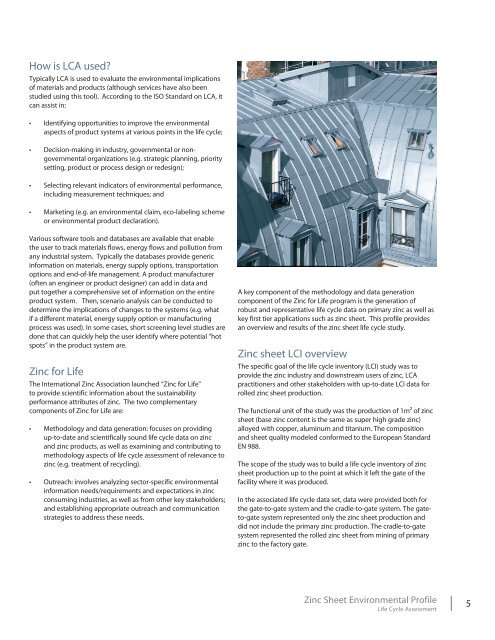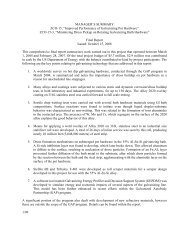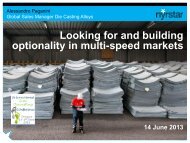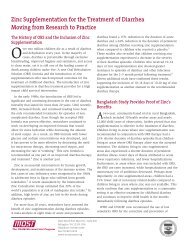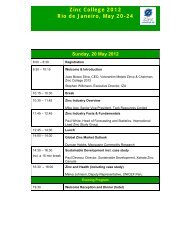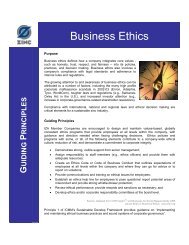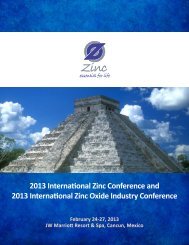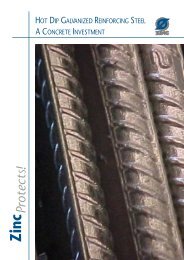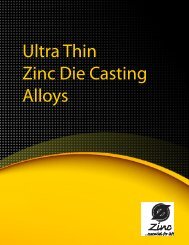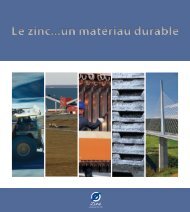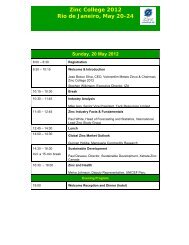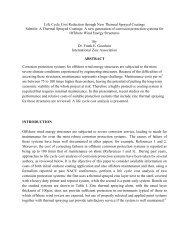Zinc Sheet Environmental Profile - Life Cycle Assessment
Zinc Sheet Environmental Profile - Life Cycle Assessment
Zinc Sheet Environmental Profile - Life Cycle Assessment
You also want an ePaper? Increase the reach of your titles
YUMPU automatically turns print PDFs into web optimized ePapers that Google loves.
How is LCA used?<br />
Typically LCA is used to evaluate the environmental implications<br />
of materials and products (although services have also been<br />
studied using this tool). According to the ISO Standard on LCA, it<br />
can assist in:<br />
• Identifying opportunities to improve the environmental<br />
aspects of product systems at various points in the life cycle;<br />
• Decision-making in industry, governmental or nongovernmental<br />
organizations (e.g. strategic planning, priority<br />
setting, product or process design or redesign);<br />
• Selecting relevant indicators of environmental performance,<br />
including measurement techniques; and<br />
• Marketing (e.g. an environmental claim, eco-labeling scheme<br />
or environmental product declaration).<br />
Various software tools and databases are available that enable<br />
the user to track materials flows, energy flows and pollution from<br />
any industrial system. Typically the databases provide generic<br />
information on materials, energy supply options, transportation<br />
options and end-of-life management. A product manufacturer<br />
(often an engineer or product designer) can add in data and<br />
put together a comprehensive set of information on the entire<br />
product system. Then, scenario analysis can be conducted to<br />
determine the implications of changes to the systems (e.g. what<br />
if a different material, energy supply option or manufacturing<br />
process was used). In some cases, short screening level studies are<br />
done that can quickly help the user identify where potential “hot<br />
spots” in the product system are.<br />
<strong>Zinc</strong> for <strong>Life</strong><br />
The International <strong>Zinc</strong> Association launched “<strong>Zinc</strong> for <strong>Life</strong>”<br />
to provide scientific information about the sustainability<br />
performance attributes of zinc. The two complementary<br />
components of <strong>Zinc</strong> for <strong>Life</strong> are:<br />
• Methodology and data generation: focuses on providing<br />
up-to-date and scientifically sound life cycle data on zinc<br />
and zinc products, as well as examining and contributing to<br />
methodology aspects of life cycle assessment of relevance to<br />
zinc (e.g. treatment of recycling).<br />
• Outreach: involves analyzing sector-specific environmental<br />
information needs/requirements and expectations in zinc<br />
consuming industries, as well as from other key stakeholders;<br />
and establishing appropriate outreach and communication<br />
strategies to address these needs.<br />
A key component of the methodology and data generation<br />
component of the <strong>Zinc</strong> for <strong>Life</strong> program is the generation of<br />
robust and representative life cycle data on primary zinc as well as<br />
key first tier applications such as zinc sheet. This profile provides<br />
an overview and results of the zinc sheet life cycle study.<br />
<strong>Zinc</strong> sheet LCI overview<br />
The specific goal of the life cycle inventory (LCI) study was to<br />
provide the zinc industry and downstream users of zinc, LCA<br />
practitioners and other stakeholders with up-to-date LCI data for<br />
rolled zinc sheet production.<br />
The functional unit of the study was the production of 1m² of zinc<br />
sheet (base zinc content is the same as super high grade zinc)<br />
alloyed with copper, aluminum and titanium. The composition<br />
and sheet quality modeled conformed to the European Standard<br />
EN 988.<br />
The scope of the study was to build a life cycle inventory of zinc<br />
sheet production up to the point at which it left the gate of the<br />
facility where it was produced.<br />
In the associated life cycle data set, data were provided both for<br />
the gate-to-gate system and the cradle-to-gate system. The gateto-gate<br />
system represented only the zinc sheet production and<br />
did not include the primary zinc production. The cradle-to-gate<br />
system represented the rolled zinc sheet from mining of primary<br />
zinc to the factory gate.<br />
<strong>Zinc</strong> <strong>Sheet</strong> <strong>Environmental</strong> <strong>Profile</strong><br />
<strong>Life</strong> <strong>Cycle</strong> <strong>Assessment</strong><br />
5


